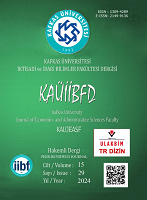THE HELMAND RIVER WATER DISPUTE BETWEEN IRAN AND AFGHANISTAN: HISTORICAL BACKGROUND, POTENTIAL RISKS AND PROPOSED SOLUTIONS
THE HELMAND RIVER WATER DISPUTE BETWEEN IRAN AND AFGHANISTAN: HISTORICAL BACKGROUND, POTENTIAL RISKS AND PROPOSED SOLUTIONS
Author(s): Damla KocatepeSubject(s): Cultural history, Political history, Social history, Environmental interactions, Socio-Economic Research
Published by: Kafkas Üniversitesi Sağlık, Kültür ve Spor Daire Başkanlığı Dijital Baskı Merkezi
Keywords: Helmand River; transboundary waters; Iran; Afghanistan; Sistan and Baluchistan;
Summary/Abstract: The dispute over the allocation of water in the Helmand River has been ongoing between Iran and Afghanistan for many years. Despite various steps taken and the agreement reached in 1973, the issue remains unresolved, causing tensions between the two countries, especially during drought periods. The prepared study aims to provide answers to why river water is so important and why the issue has not yet been resolved through historical and strategic analyses. However, beyond this, the main focus and therefore the purpose of this study is to identify the potential risks that may arise if the problem remains unresolved and to propose solutions. In this context, the study attempts to provide some concrete suggestions through the benefit-sharing theory categorized into four headings by Claudia W. Sadoff and David Grey, thereby offering an alternative perspective for a solution. This study argues that if the water issue persists, certain developments may emerge in both countries, but particularly in Iran, which could affect both internal and regional balances.
Journal: Kafkas Üniversitesi İktisadi ve İdari Bilimler Fakültesi Dergisi
- Issue Year: 15/2024
- Issue No: 29
- Page Range: 308-333
- Page Count: 26
- Language: English

